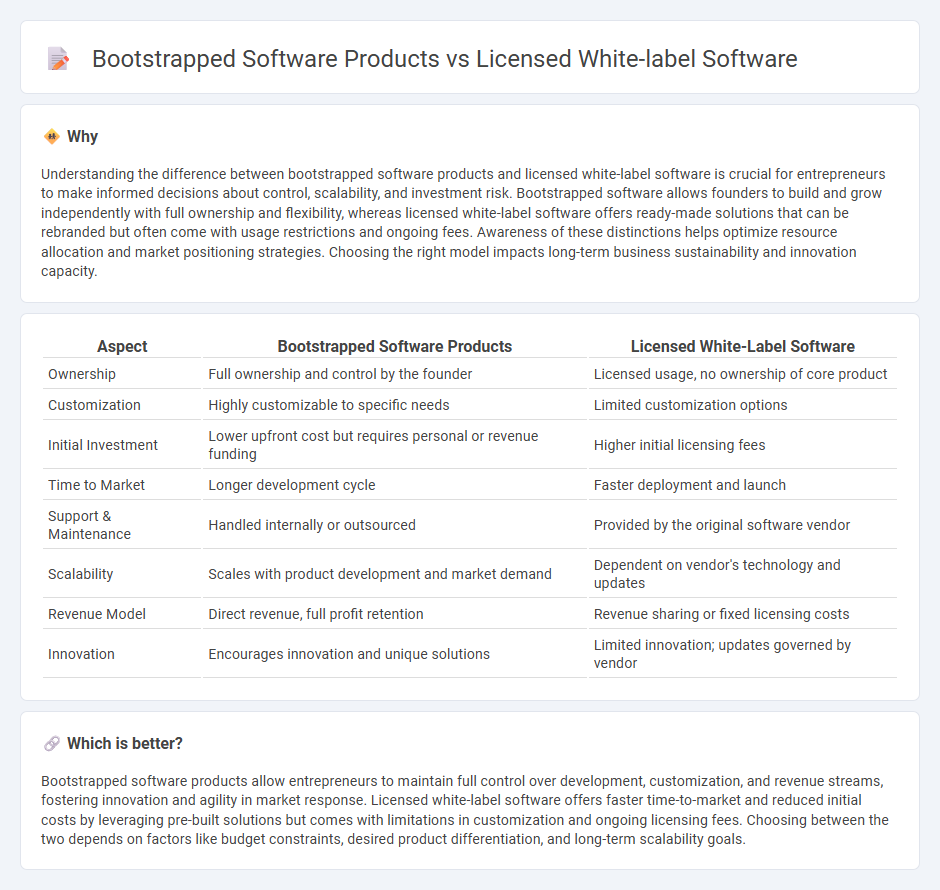
Bootstrapped software products are developed and funded independently by entrepreneurs, enabling full control over product features and business direction, often leading to innovative, tailored solutions. Licensed white-label software involves purchasing pre-built platforms with branding rights, enabling rapid market entry and reduced development costs but with limited customization. Explore the key differences and strategic benefits of each approach to optimize your software venture.
Why it is important
Understanding the difference between bootstrapped software products and licensed white-label software is crucial for entrepreneurs to make informed decisions about control, scalability, and investment risk. Bootstrapped software allows founders to build and grow independently with full ownership and flexibility, whereas licensed white-label software offers ready-made solutions that can be rebranded but often come with usage restrictions and ongoing fees. Awareness of these distinctions helps optimize resource allocation and market positioning strategies. Choosing the right model impacts long-term business sustainability and innovation capacity.
Comparison Table
| Aspect | Bootstrapped Software Products | Licensed White-Label Software |
|---|---|---|
| Ownership | Full ownership and control by the founder | Licensed usage, no ownership of core product |
| Customization | Highly customizable to specific needs | Limited customization options |
| Initial Investment | Lower upfront cost but requires personal or revenue funding | Higher initial licensing fees |
| Time to Market | Longer development cycle | Faster deployment and launch |
| Support & Maintenance | Handled internally or outsourced | Provided by the original software vendor |
| Scalability | Scales with product development and market demand | Dependent on vendor's technology and updates |
| Revenue Model | Direct revenue, full profit retention | Revenue sharing or fixed licensing costs |
| Innovation | Encourages innovation and unique solutions | Limited innovation; updates governed by vendor |
Which is better?
Bootstrapped software products allow entrepreneurs to maintain full control over development, customization, and revenue streams, fostering innovation and agility in market response. Licensed white-label software offers faster time-to-market and reduced initial costs by leveraging pre-built solutions but comes with limitations in customization and ongoing licensing fees. Choosing between the two depends on factors like budget constraints, desired product differentiation, and long-term scalability goals.
Connection
Bootstrapped software products often evolve into licensed white-label software as startups seek scalable revenue streams and broader market reach. Licensing white-label software enables entrepreneurs to monetize their bootstrapped innovations by allowing other businesses to rebrand and customize the core product. This synergy accelerates growth, reduces marketing overhead, and leverages existing technology to expand into diverse industries.
Key Terms
Intellectual Property Rights
Licensed white-label software allows companies to rebrand and resell products under their name without owning the underlying intellectual property rights, which remain with the original creator. Bootstrapped software products grant full ownership of intellectual property to the founders, enabling complete control over development, distribution, and licensing. Explore further to understand the strategic impact of intellectual property rights on software business models.
Customization Flexibility
Licensed white-label software offers extensive customization flexibility, enabling businesses to tailor features and branding according to specific needs while leveraging a proven platform. Bootstrapped software products typically provide greater freedom to innovate from the ground up but may require significant development resources and time to achieve desired customization levels. Explore detailed comparisons to determine which approach best aligns with your customization goals and business strategy.
Upfront Investment
Licensed white-label software requires a significant upfront investment to purchase or subscribe to a ready-made solution that can be rebranded and customized, reducing time-to-market and development risks. Bootstrapped software products demand lower initial capital but involve considerable effort and resources in development, testing, and refining without external funding. Explore detailed comparisons and strategic insights to determine which approach best aligns with your business goals and financial capacity.
Source and External Links
White-Label Arrangements - Tech & Sourcing @ Morgan Lewis - A white label software license regulates how a licensee can use software under their own brand without disclosing the original developer, including typical licensing terms and intellectual property protections.
Top 5 White Label Software To Resell In 2025 - CustomGPT.ai - Lists top white label software for resale in 2025 across niches like AI automation, marketing, and client management, highlighting platforms like CustomGPT.ai, GoHighLevel, and Vendasta, noting features and branding customization.
White Label Software - What is it? Why Use it? - Defines white label software as unbranded software rebranded and sold by another company, typically as SaaS, serving many types including marketing tools, web design, and SEO software, with emphasis on subscription models and branding control.
 dowidth.com
dowidth.com